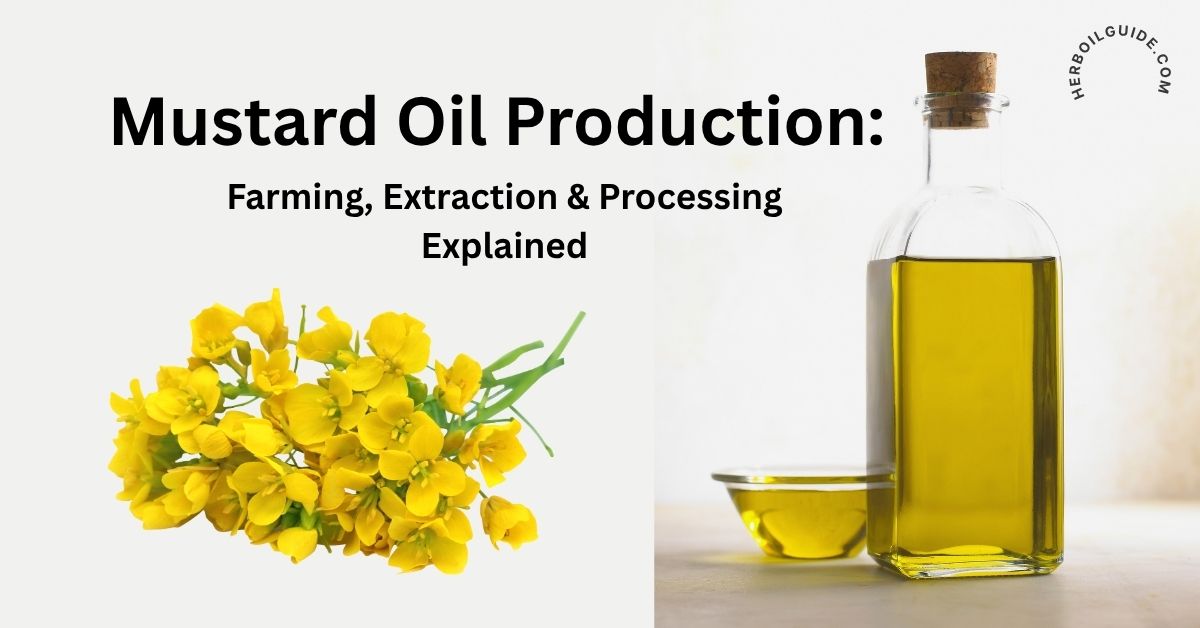Mustard Oil Production: Farming, Extraction & Processing Explained

Mustard oil begins its journey long before it reaches the bottle. From the careful cultivation of mustard plants to the intricate techniques used in its extraction, every step affects its quality, nutrition, and health benefits. This guide dives into the entire cycle—farming, harvesting, seed cleaning, oil extraction methods, and the production process—ensuring readers understand how high-quality mustard oil is produced today.
1. Farming and Cultivation of Mustard Plants
Mustard oil starts at the farm. The process begins with selecting high-quality mustard seeds, usually from yellow or black mustard plants. These seeds are sown during the winter months in countries like Pakistan, India, Bangladesh, and Nepal, where mustard farming is prevalent.
To produce premium oil, the mustard plants must be grown under conditions that preserve their natural nutrients. The use of organic fertilizers, minimal pesticide application, and timely irrigation are vital for ensuring the quality of mustard seeds, which directly impacts the oil yield and nutritional value of the final product.
2. Harvesting and Seed Cleaning
When the plants mature, usually 90–100 days after sowing, mustard pods are harvested and dried. The dried seeds are separated and cleaned through sieving and air-blowing to remove impurities, dust, and husk, ensuring that only clean, viable mustard seeds are used for extraction. This cleaning step plays a significant role in maintaining oil purity. Clean seeds lead to a higher-quality extract and better shelf life. For example, cold-pressed mustard oil derived from thoroughly cleaned seeds exhibits a milder taste, rich yellow color, and a higher smoke point, suitable for cooking at high temperatures.
3. Extraction Methods
The oil can be extracted using several methods, each affecting its chemical composition and its nutritional quality
a) Cold Pressing (Kachi Ghani)
Cold pressing is the most traditional and revered method. In this technique, mustard seeds are crushed at low temperatures (below 50°C), ensuring that fatty acids, antioxidants, and bioactives like allyl isothiocyanate are preserved. This method yields cold-pressed mustard oil that retains its polyunsaturated fats and monounsaturated fatty acids, promoting heart health and lowering the risk of cardiovascular diseases. This type of oil also preserves the characteristic pungency and golden hue associated with pure mustard oil.
b) Expeller Pressing
This semi-mechanical method uses moderate heat and pressure to extract oil. While it slightly reduces the nutrient profile, it increases the oil yield. This method is more economical and commonly used in commercial production. Expeller-pressed oils still contain significant amounts of omega-3 fatty acids and monounsaturated fats, contributing to the oil's nutritional benefits.
c) Solvent Extraction
Used primarily in large-scale, industrial settings, this process involves soaking crushed seeds in chemical solvents like hexane to extract remaining oil. Though highly efficient, this method may compromise natural nutrients and introduces safety concerns, especially for culinary use. In regulated environments, solvents are removed before packaging, but cold-pressed or expeller-pressed oils are generally preferred for cooking oil due to their minimal processing. Research Reference: Frontiers in Sustainable Food Systems, 2022 discusses the nutritional loss in solvent-extracted oils versus cold-pressed oils.
4. Filtration and Packaging
Once extracted, the oil is filtered to eliminate residual particles and moisture. This step enhances stability, prevents rancidity, and prepares the oil for bottling. Premium oils undergo microfiltration to preserve flavor and nutritional content while ensuring purity. For example, organic mustard oil—especially cold-pressed and unrefined—retains its high antioxidant profile, contributes to better skin health, and can be used for body massage and hair treatments.
5. Factors Affecting Oil Quality
The quality of mustard oil depends on multiple factors:
- Seed quality: Genetically pure, mature seeds produce better yields.
- Extraction method: Cold pressing retains more nutrients.
- Storage conditions: Oil should be stored in airtight, dark containers to prevent oxidation.
A well-produced mustard oil contains allyl isothiocyanate for antimicrobial benefits, erucic acid in controlled amounts for energy metabolism, and a balanced mix of monounsaturated and polyunsaturated fats for nutritional benefits. Research Reference: Journal of Food Science and Technology, 2021 confirms that cold-pressed mustard oil has superior oxidative stability and higher retention of antioxidants.
FAQs
1. What is the best method for extracting mustard oil at home?
Cold pressing using a manual or mechanical expeller without heat is ideal for retaining nutrients.
2. Does mustard oil contain harmful chemicals?
Pure mustard oil contains natural bioactives like allyl isothiocyanate and erucic acid. It's safe when consumed in moderation.
3. Which part of the mustard plant is used for oil?
Oil is extracted from the mustard seeds, not the leaves or stems.
4. Is cold-pressed mustard oil better than refined?
Yes. Cold-pressed oil retains more nutrients, antioxidants, and flavor than refined oils.
5. How can I tell if mustard oil is pure?
Look for golden yellow color, sharp aroma, and labels like "cold-pressed" or "organic". Avoid oils with added color or flavor.